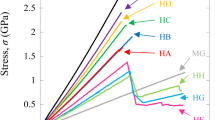Abstract
The tensile properties of high strength polyacrylonitrile-based (IM600) and high modulus pitch-based (K13D) hybrid carbon fibers-reinforced epoxy matrix composite (CFRP) were investigated. Fiber orientation of the hybrid CFRP specimen was set to [0(IM600)/0(K13D)]2S. The fiber volume fraction of the hybrid CFRP specimen was 55.7 vol% (IM600: 29.3 vol%, K13D: 26.4 vol%). The tensile stress–strain curve of the hybrid CFRP specimen shows a complicated shape (jagged trace). By the high modulus K13D CFRP layers, the hybrid CFRP specimen shows the intermediate modulus in the initial stage of loading. Subsequently, when the K13D CFRP layers begin to fail, the high strength IM600 CFRP layers would hold the load (strength) and the material continues to endure high load without instantaneous failure. Because higher strength fiber can help the load for a certain time after failure occur, the hybrid composite could be considered one example of a material possessing preventing instantaneous failure. The Weibull statistical distributions of the mono (IM600 and K13D) and the hybrid CFRP specimens were also examined. The Weibull modulus for the mono CFRP specimens was calculated to be 22.9 for the IM600 CFRP specimen and 14.4 for the K13D CFRP specimen, respectively. The Weibull modulus for the hybrid CFRP specimen was calculated to be 39.6 for the initial fracture strength and 20.6 for the tensile fracture strength, respectively. The Weibull modulus for the initial fracture strength is higher than that for the K13D CFRP specimen and the Weibull modulus for the tensile fracture strength is almost similar to that for the IM600 CFRP specimen.








Similar content being viewed by others
Notes
The cure cycle is 1 ºC/min for 2 h 37 min (from 23 to 180 ºC) and then 4 h at 180 ºC.
References
Fitzer E (1989) Carbon 27(5):621. doi:10.1016/0008-6223(89)90197-8
Chand S (2000) J Mater Sci 35(6):1303. doi:10.1023/A:1004780301489
Rosa LG, Colella A, Anjinho CA (2006) Mater Sci Forum 514–516:672. doi:10.4028/www.scientific.net/MSF.514-516.672
Bunsell AR, Harris B (1974) Composites 5(4):157. doi:10.1016/0010-4361(74)90107-4
Summerscales J, Short D (1978) Composites 9(3):157. doi:10.1016/0010-4361(78)90341-5
Aveston J, Kelly A (1980) Philos T R Soc A 294(1411):519. doi:10.1098/rsta.1980.0061
Short D, Summerscales J (1984) Composites 15(3):200. doi:10.1016/0010-4361(84)90275-1
Hayashi T, Koyama K, Yamazaki A, Kihira M (1972) Fukugo Zairyo (composite materials) 1:21–25
Short D, Summerscales J (1979) Composites 10(4):215. doi:10.1016/0010-4361(79)90022-3
Short D, Summerscales J (1980) Composites 11(1):33. doi:10.1016/0010-4361(80)90019-1
Hardaker KM, Richardson MOW (1980) Polym-Plast Technol 15(2):169. doi:10.1080/03602558008070011
Chow TW, Kelly A (1980) Ann Rev Mater Sci 10:229. doi:10.1146/annurev.ms.10.080180.001305
Manders PW, Bader MG (1981) J Mater Sci 16(8):2233. doi:10.1007/BF00542386
Morgan P (2005) In: Morgan P (ed) Carbon fibers and their composites. Taylor, New York, p 791
Huang Y, Young RJ (1995) Carbon 33(2):97. doi:10.1016/0008-6223(94)00109-D
Paiva MC, Bernardo CA, Nardin M (2000) Carbon 38(9):1323. doi:10.1016/S0008-6223(99)00266-3
Paris O, Loidl D, Peterlik H (2002) Carbon 40(4):551. doi:10.1016/S0008-6223(01)00139-7
Naito K, Tanaka Y, Yang JM, Kagawa Y (2008) Carbon 46(2):189. doi:10.1016/j.carbon.2007.11.001
Naito K (2010) In: Takahashi A (ed) Impregnation ability of resin for carbon fiber reinforced polymer matrix composite and reliability assessment in Japanese. Gijutu-Joho-Kyokai, Tokyo, p 34
Naito K, Yang JM, Tanaka Y, Kagawa Y (2011) J Mater Sci in accepted. doi:10.1007/s10853-011-5832-x
Marom G, Fischer S, Tuler FR, Wagner HD (1978) J Mater Sci 13(7):1419. doi:10.1007/BF00553194
Stevanovic MM, Stecenko TB (1992) J Mater Sci 27(4):941. doi:10.1007/BF01197646
Yao L, Li WB, Wang N, Li W, Guo X, Qiu YP (2007) J Mater Sci 42(16):6494. doi:10.1007/s10853-007-1534-9
Kretsis G (1987) Composites 18(1):13. doi:10.1016/0010-4361(87)90003-6
You YJ, Park YH, Kim HY, Park JS (2007) Comps Struct 80(1):117. doi:10.1016/j.compstruct.2006.04.065
Zweben C (1977) J Mater Sci 12(7):1325. doi:10.1007/BF00540846
Manders PW, Bader MG (1981) J Mater Sci 16(8):2246. doi:10.1007/BF00542387
Fukunaga H, Chou TW, Fukuda H (1989) Compos Sci Technol 35(4):331. doi:10.1016/0266-3538(89)90056-0
Qiu YP, Schwartz P (1993) Compos Sci Technol 47(3):289. doi:10.1016/0266-3538(93)90037-H
Jones KD, Dibenedetto AT (1994) Compos Sci Technol 51(1):53. doi:10.1016/0266-3538(94)90156-2
Fukuda H (1984) J Mater Sci 19(3):974. doi:10.1007/BF00540468
Hedgepeth JM (1961) Stress concentrations in filamentary structures. NASA TN D-882
Aveston J, Sillwood JM (1976) J Mater Sci 11(10):974. doi:10.1007/BF00708266
Budiansky B, Hutchinson JW, Evans AG (1986) J Mech Phys Solids 34(2):167. doi:10.1016/0022-5096(86)90035-9
Kazmin VI, Mileiko ST, Tvardovsky VV (1990) Compos Sci Technol 38(1):69. doi:10.1016/0266-3538(90)90072-D
Weibull W (1951) J Appl Mech 18:293
Irwin GR (1957) J Appl Mech 24:361
Benzeggagh ML, Gong XJ, Laksimi A, Roelandt JM (1991) Polym Eng Sci 31(17):1286. doi:10.1002/pen.760311709
Hwang SF, Shen BC (1999) Compos Sci Technol 59(12):1861. doi:10.1016/S0266-3538(99)00047-0
Author information
Authors and Affiliations
Corresponding author
Rights and permissions
About this article
Cite this article
Naito, K., Yang, JM. & Kagawa, Y. Tensile properties of high strength polyacrylonitrile (PAN)-based and high modulus pitch-based hybrid carbon fibers-reinforced epoxy matrix composite. J Mater Sci 47, 2743–2751 (2012). https://doi.org/10.1007/s10853-011-6101-8
Received:
Accepted:
Published:
Issue Date:
DOI: https://doi.org/10.1007/s10853-011-6101-8




